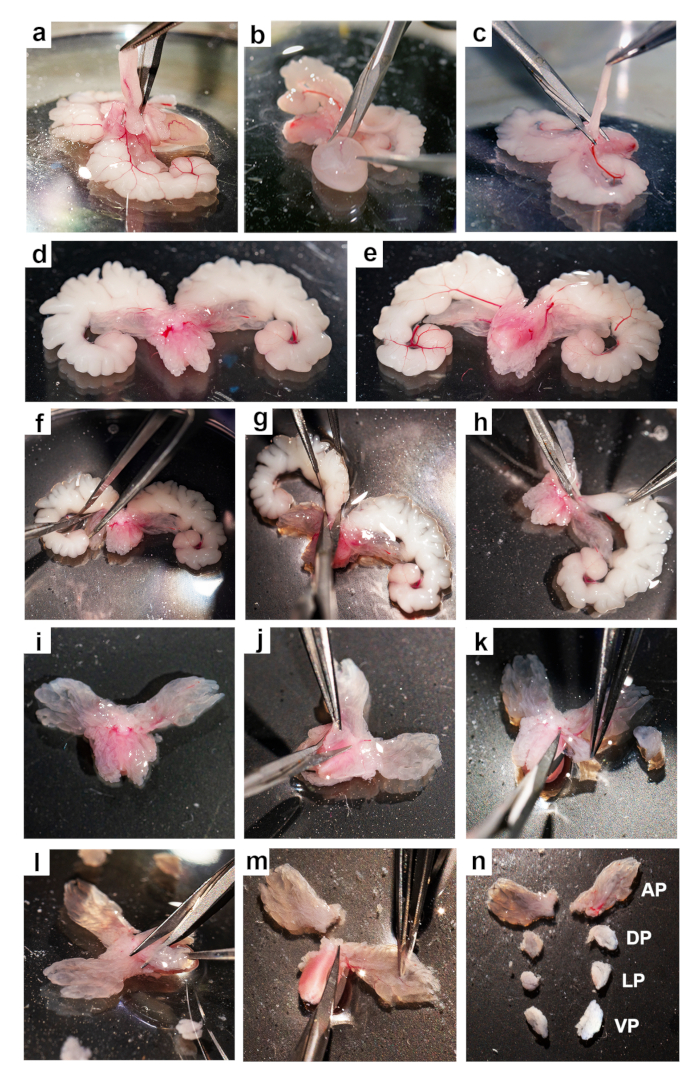A subscription to JoVE is required to view this content. Sign in or start your free trial.
Individual Lobe Extraction from Prostate: A Technique to Harvest Individual Prostate Lobes from Mouse Prostate
In This Article
Overview
This video describes a technique to harvest individual lobes from the prostate gland of a mouse model. Individual lobes can then be used for histological analysis and cancer research.
Protocol
All procedures involving animals have been reviewed by the local institutional animal care committee and the JoVE veterinary review board.
1. Gross Anatomy of the Prostate and Individual Lobe Microdissection
NOTE: This is depicted in Figures 1(i-n) and Figure 2
- Flip the tissue with a pair of blunt forceps so that the dorsal side faces up, showing the dorsal lobes, which resemble a butterfly’s wings.
- Collect the dorsal lobes by holding the lobe with forceps and snipping at the base with scissors (Figure 1j).
- Flip over the remaining tissue to the ventral side.
- Collect the lateral lobes, which are small and usually wrap the urethra on the side, which are wedged between the anterior, ventral, and dorsal lobes (Figure 1k).
- Next, collect the ventral lobes, which are larger than the lateral lobes and lie on the urethra ventrally (Figure 1l).
- Last, harvest the anterior lobes, the largest of the four, by cutting and discarding the urethra (Figure 1m).
- Process the tissue pieces according to experimental needs.
תוצאות

Figure 1: Dissection of the mouse prostate. Step-by-step images for the dissection of the mouse prostate from the UGS: (a) removing fat, (b) removing the urinary bladder, (c) removing the vas deferens, (d) ventral view of the prostate with the urethra, (e) dorsal view of the prostate with the urethra, (f-...
Disclosures
Materials
| Name | Company | Catalog Number | Comments |
| Mouse surgical instruments (Mouse Dissecting kit) | World Precision Instruments | MOUSEKIT | |
| Dissection microscope | |||
| RPMI medium | Thermofisher Scientific | 11875093 | |
| Dissection medium (DMEM + 10%FBS) | Thermofisher Scientific | 11965-084 | |
| Fetal Bovine Serum | Thermofisher Scientific | 10438018 | |
| PBS (Phosphate buffered saline) | Thermofisher Scientific | 10010031 | |
| Collagenase | Thermofisher Scientific | 17018029 | Make 10x stock (10mg/ml) in RPMI, filter sterilize, aliquot and store at -20 °C |
| Syringes and Needles | Fisher Scientific |
This article has been published
Video Coming Soon
Source: Nath, D. et al. Identification, Histological Characterization, and Dissection of Mouse Prostate Lobes for In Vitro 3D Spheroid Culture Models. J. Vis. Exp. (2018)
Copyright © 2025 MyJoVE Corporation. All rights reserved